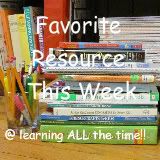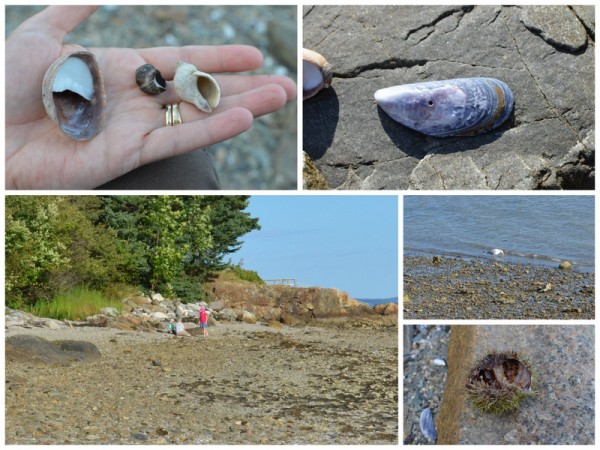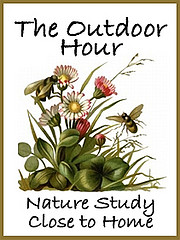 Hi, I'm Heidi and I homeschool my two sweet kids. I want them to know that learning is an exciting lifelong adventure! We love great books, unit studies, notebooking, lapbooking, and hands-on learning.
Hi, I'm Heidi and I homeschool my two sweet kids. I want them to know that learning is an exciting lifelong adventure! We love great books, unit studies, notebooking, lapbooking, and hands-on learning.Nature Study ~ Trees
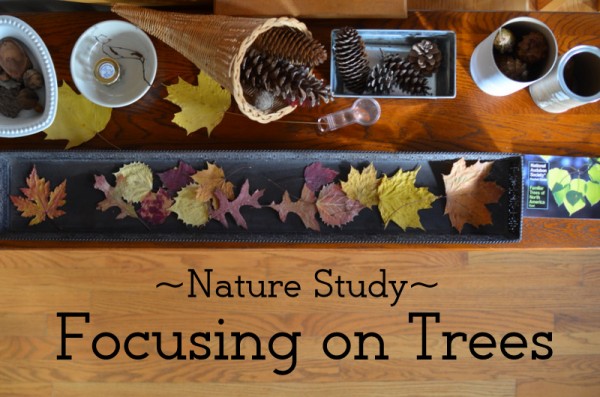
I wrote about how we kicked off our nature study focus on trees by writing poems about trees. Since then we’ve been learning a lot about trees and I still feel like we’re just beginning! I set up our nature table with any tree-related specimens and books and we added more cones and leaves throughout our study. (Just a side note: I keep boxes in our basement for nature items and only display the ones for the nature topic we are focusing on. Rotating what we have out keeps it more interesting.)
Leaves
One of Barb’s posts from a couple years ago on Seasonal Tree Observations linked to a great printable for leaf shape and arrangement. It is one of those things I’ll add to my binder and try to learn but I have to reign in the urge to download my brain into my children. Charlotte Mason cautions against talking at your kids so much in nature that you take away their chance to experience it and see what they are interested in. (Here’s an older post of mine about stepping back when we’re in nature with some advice straight from Ms. Mason.) If I focus on learning the information myself I can answer questions and teach vocabulary in context as we marvel at the things we see. The author of the Handbook of Nature Study states it this way:
The child should never be required to learn the name of anything in the nature-study work; but the name should be used so often and so naturally in his presence that he will learn it without being conscious of the process.” ~Anna Botsford Comstock
We’d been enjoying Maine’s beautiful foliage displays so our first quest was to understand how and why leaves change colors in the fall. We watched a short video from the Maine Department of Conservation about the changing colors in leaves. We brought some brilliant yellow leaves in and examined them with the stereoscope and microscope. The kids drew as a way to record what they saw. This quote from my son illustrates why I love using a hand lens, stereoscope and microscope when we can:
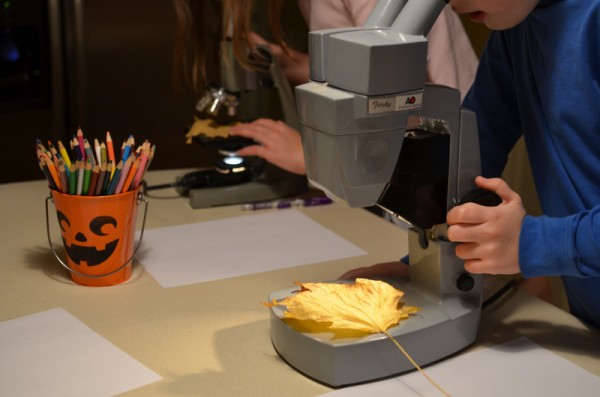
“I didn’t know leaves were so interesting!”
We learned about another timely aspect of fall: there is a thin layer that forms between the leaf’s stem (petiole) and the twig, allowing the leaf to drop and most importantly to kids: leading to piles like this to jump in!
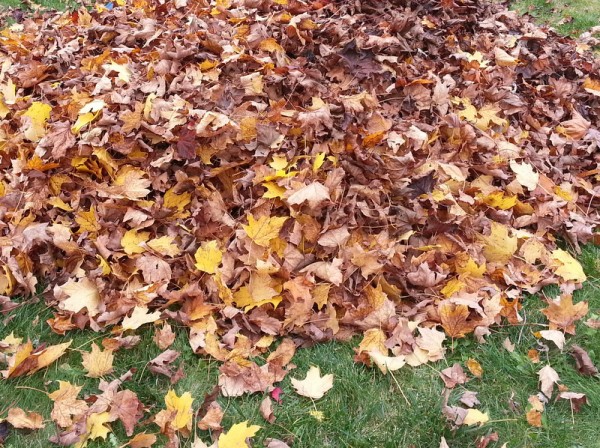
Learning about the cycles of leaves forming a separation layer, then falling off and feeding the tree as they break down into the soil, followed by new buds in place just above the scar waiting to be next year’s leaves led us to take a trip around the yard to see these signs of years past, this year, and years to come on our own trees.
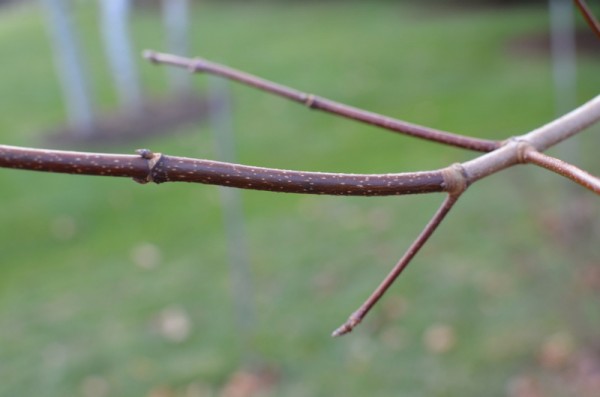
With the excitement of brilliant fall leaves we focused on deciduous trees initially, so then it was time to move onto evergreens. We made our annual trek to the Christmas Tree Farm and our studies continued with a beautiful specimen right in our living room!
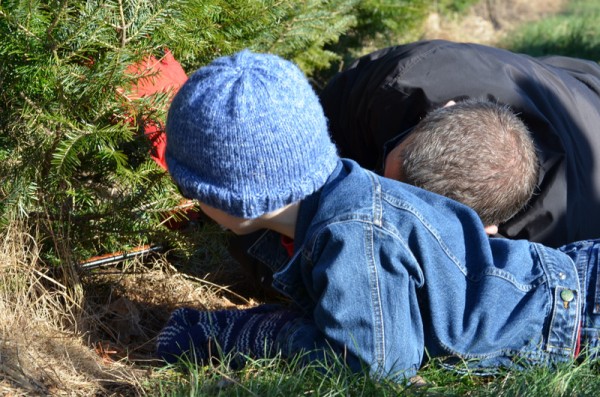
Flowers, Seeds and Cones
I’ll look forward to revisiting this topic in the spring and early summer when the maple trees in our yard bloom, but fall was a great time to study cones and acorns. We were able to get a good look at two different types of cones and one variety of acorn. I grabbed cones from the ground under two backyard trees and placed them in empty cardboard containers so the kids could watch the transformation and see the treasure inside a cone.
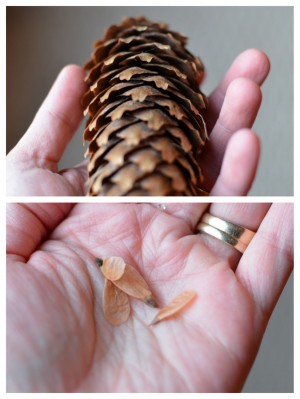
Bark
The bark looked incredible under the stereoscope. We read in one of our books about how bark was like skin to protect the tree, but since it doesn’t stretch it looks wrinkled and peeling and has cracks. That is how the tree expands as it grows!
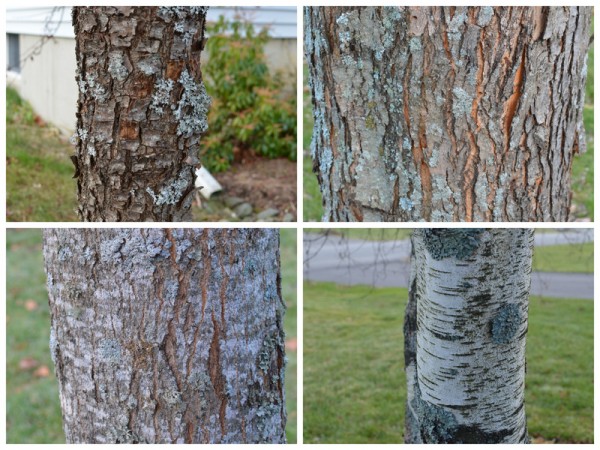
Roots
We took a couple hikes during the month to enjoy time in the forest. It gave us a good chance to observe some root systems of trees that have fallen. My son said this one looked like a dinosaur with a large eye and mouth coming out of the ground!
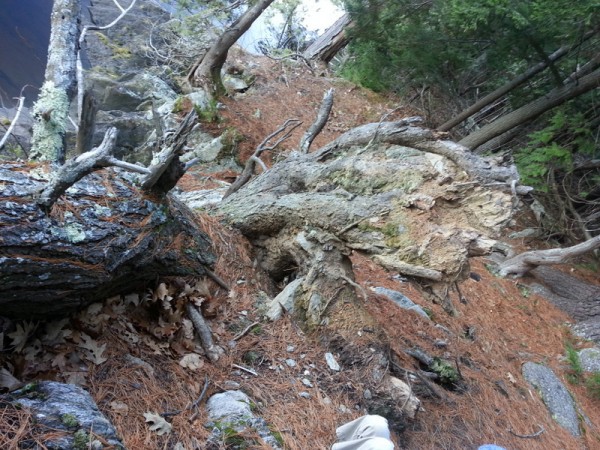
Trees just seem to spark the imagination. This tree immediately gave my daughter an idea for a story, with the cut branch being a secret keyboard to access an underground world.
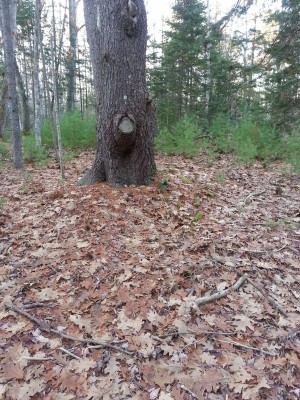
Identification
Our neighborhood is relatively young, and many of the trees in our yard (21 to be exact!) have been planted by me in the past 5 years. I’ve been working to identify those that were already planted. My plan is to make our own field guide beginning with the trees from our yard (Outdoor Hour Challenge #7). We were inspired by a local homeschool family who showed us their leaf collection and this post from Brandy at Half-a-Hundred Acre Wood. She includes a free printable notebook page to identify and record the tree and a leaf sample.
Luckily I’d collected and pressed leaves from a few trees this fall. I want to include actual leaves and seeds when possible, and photos of items like cones and bark. We’ll have to continue this project once there are leaves to be seen outside in Maine…like next May. Commercial field guides are a wonderful resource, but there is great value in making your own book of things you have right outside your door.
After we learn a little about our different trees we’ll choose one for a year-long study. We’ll probably start with the large spruce that forms part of what my kids call their “secret hideout” with it’s large drooping branches. Barb has a helpful post with ideas for a year-long seasonal tree study and I also like this post that will persuade you of the benefits of studying one tree over the course of the four seasons.
Book and Internet Resources:
- The Handbook of Nature Study: the resource for all our nature study, used as a reference for me (not a read aloud).
- Barb at The Handbook of Nature Study Blog continually inspires me to study nature with my kids. She has a great reference page with links to many of her tree studies (both specific trees, parts of trees, and seasonal ideas) and a free download.
- National Audubon Society Pocket Guide: Familiar Trees of North America East: I like this small, colorful field guide. For each tree there is a sillhouete to show the overall shape, a full page photo (not drawing) of the leaves, and a small close-up of the bark. My only complaint: I wish it had a photo of the cones or seeds for each tree.
- I came across a great book at our library that I’ll be adding to our collection, though it is only available used. Inside and Outside Trees by Sandra Markle is filled with beautiful photos and easy to understand explanations. This was a perfect read aloud: just a couple pages at a time and then we’d look for the things we read about during our outside time. It helped the kids have lots of “a-ha” moments when they found a leaf scar or something else they could recognize from the pictures in the book.
- Eyewitness Books: Trees is another reference we used. When you can’t observe everything up close and personal in nature the gorgeous photography in the DK Eyewitness Books is a good stand-in.
- An online guide to the parts of a tree: this has some of the same information from the printable in Barb’s post (on leaf shape and arrangement), but also has nice graphics for tree shape, twig structures, and the different types of flowers, seeds and cones. It does not give you the identification, but helps you learn about the structures used in identifying trees. That way if you read details about a tree’s stipule scars, incised or pinnately compound leaves, or drupes you know what on earth to look for.
- The online guide from the Arbor Day Foundation called “What Tree is That?” is the best resource I’ve found for identifying a tree. It is so easy to use: just answer one question at a time to arrive at the identification. My kids enjoy using this with me as I ask them the questions and they tell me which choice on the screen applies to the tree we’re looking at. We used this to identify our Christmas tree as a balsam fir.
- I always try to find a few related picture books for fun. This time we’re enjoying: Christmas Tree Farm by David Budbill, an illustrated picture book of a Robert Frost poem called Christmas Trees, and Arbor Day Square by Kathryn O. Galbraith (which also ties into our history studies–it’s about the beginning of Arbor Day out on the prairie in the 1800’s).
Now our nature table has been cleared off to make room for our Christmas Village. Our homeschool runs pretty differently during December. Over the next couple weeks I’ll be sharing how we focus on the holiday and still learn a lot. And then looking ahead in our nature study we’ll start a focus area on birds in January. That way we’ll be ready for our second year participating in the Great Backyard Bird Count!
Nature Study ~ Kicking Off Our Focus on Trees With Poetry
I’d intended to start our nature study focus on trees a couple weeks ago when the beauty of the fall leaves was at its peak in Maine, but we were very busy preparing for our science fair. Then my basement flooded and messed with all my plans!
To get back into the swing of nature study (and do something that didn’t require a lot of planning or knowledge from me) we took a walk around our neighborhood using the ideas in Barb’s Outdoor Hour Challenge #2, Use Your Words. My daughter recorded a list of the words that came to our minds when we looked at all the trees on our walk. Our neighborhood is fairly young (20 years), and though most house lots had originally been completely cleared there are woods surrounding the neighborhood and many lawns are adorned with a variety of trees. I’ve enjoyed paying particular attention to the variety of leaf color and timing for the change. Many trees in our neighborhood are now bare, but a maple in our back yard is just glowing with gold leaves now.
The next day as the rain poured down and the wind howled, we spent a cozy evening turning our words about trees into poetry using Barb’s free printable with easy suggestions. Each of us used a different idea. My son (age 7) traced leaves I had pressed weeks ago, added veins, and I wrote his selected words inside the leaves.
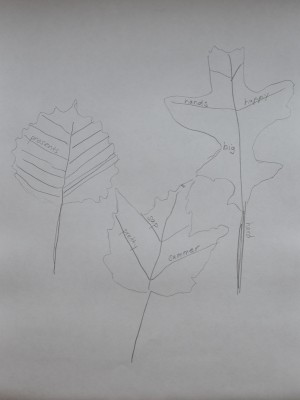
My daughter (age 10) was intrigued by the cinquain idea. I was very proud of her work.
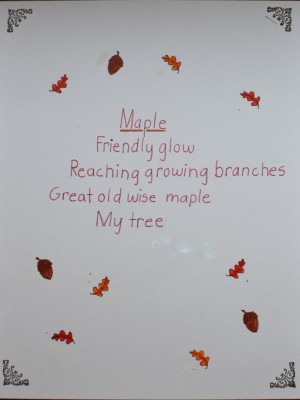
I joined the fun (the kids love it when I do). My particular interest was noticing the pattern of colors on each of the pressed leaves I traced. I wrote my words around the perimeter of my leaves.
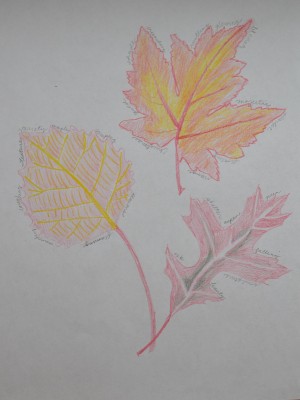
Our poems are hanging on our wall, and we are excited to spend some time studying trees. Our first question: why do leaves change color?
Before I end I have to add a note. On our walk some movement in a fake spiderweb at a neighbor’s house caught my eye. I looked closer and realized a small bird was caught. Long story short, we had to help him. The neighbors were not at home, but with the help of another neighbor and her scissors we soon had this beautiful nuthatch free from the web. He was very shaken up but did not appear injured. After some time in a box and some conversations with a bird rescue organization he flapped away from us up into a tree.
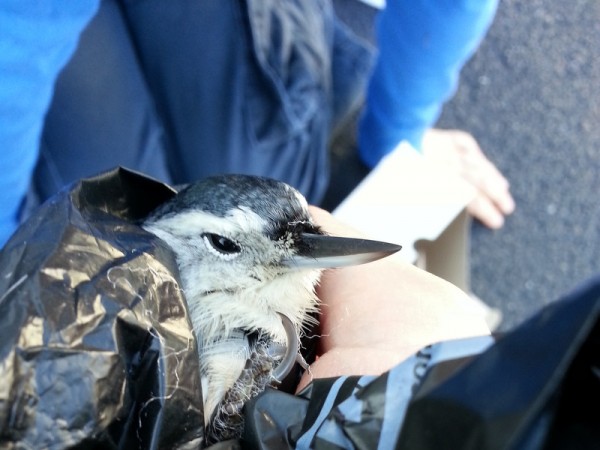
We had to leave an hour later and he was still there. We named him Webber and hope he goes on to live a long and happy life. The woman who answered my calls at the bird rescue organization told us that often owls get trapped and end up hanging for hours by a wing or leg. I tell this story because after we saw firsthand the danger of those fake spiderwebs to wildlife I said I’d spread the word. This is my little part of helping the birds.
Nature Study ~ Focusing on Insects and Spiders
We enjoy nature study using the gentle leading from Barb at the Handbook of Nature Study blog. When I purchased her “Getting Started” ebook and read in Challenge #4 about picking a focus area the idea made so much sense! When her September newsletter came out with a focus on insects and I saw that arthropods were coming up in our formal science curriculum, picking our first focus area was easy: Insects & Spiders.
I gathered related books, field guides and flashcard sets, our magnifying glasses, some specimens (purchased in acrylic and ones we’ve collected in jars). I placed all these items on a sofa table that I dubbed our “Nature Table.” The kids were intrigued and I saw a lot more handling of the specimens and flipping through the books with them all on display. It also made it easy to identify bugs we saw with all the insect books in one place.
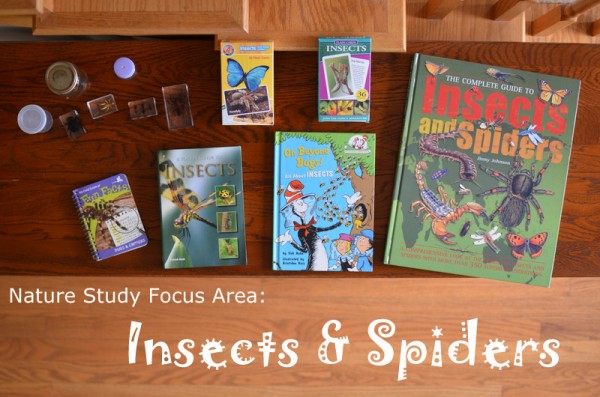
Using the September newsletter planning chart I mapped out topics I hoped to cover. She said picking a focus area helped her family learn much more in their area of concentration and that they would see more of whatever item they were focusing on, and I found this to be true in our family. Here are some of our nature study highlights for the month:
- We did a lot of reading, finally going through all the wonderful introductory pages in our Complete Guide to Insects and Spiders book.
- We watched some great videos. We always watch the YouTube links in Barb’s Outdoor Hour Challenge posts because we can see things we don’t have the good fortune of observing, like a spider spinning a web or cricket making it’s “music.” National Geographic Kids also has fun short videos and slideshows.
- We went on focused bug hunts, but also found ourselves pointing out insects to each other everywhere we went! Sometimes it seemed like insects and spiders were just waiting to be observed by us.
- Barb’s September grid gave us some things to look for on our nature walks. We found insects of many different colors, looked for ways they camouflage themselves, watched bees, and turned over rocks and logs. One of the challenges also involved looking at things through a bug’s eye view, which my son thoroughly enjoyed.
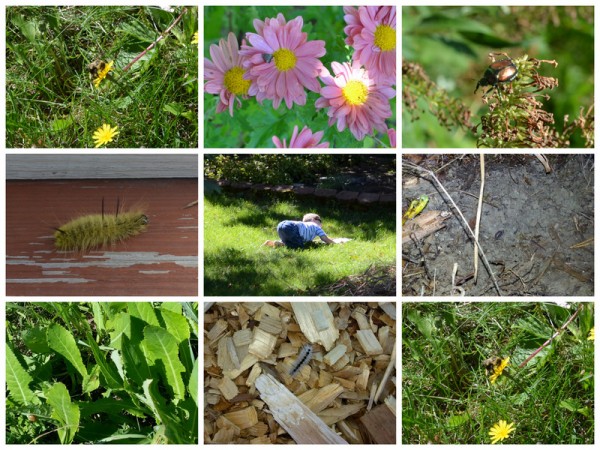
- This large spider is the perfect example of why a nature study focus area worked well for us. This exit door we’ve walked by a hundred times, but last week I noticed this spider and we stopped to observe and take photos. We admired her web (and knew it was an orb web after our studies). The most exciting part was searching all around for her children after reading about how the young spiders cast out on a line of silk in the wind. A few were in the same window! We then went outside and searched around the building, finding lots more smaller spiders that looked just like her.
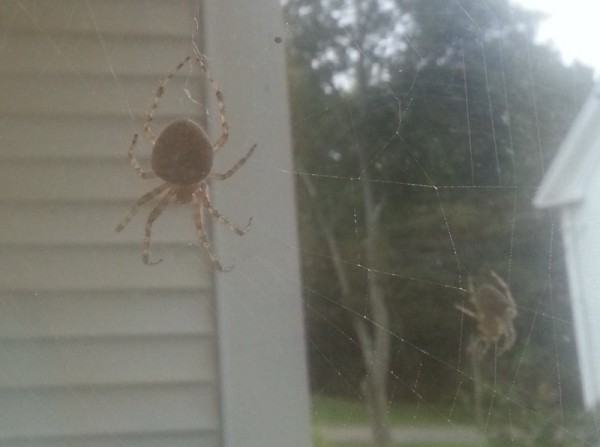
- We went on a few bug hunts in our backyard. We placed a Japanese Beetle and earwig in jars and the kids both completed a notebooking page (free from Primary Possibilities) for their journal. My daughter loved the organized format, once again my son preferred the blank page and just turned his over to draw on the back! That’s the beauty of notebooking: flexibility.
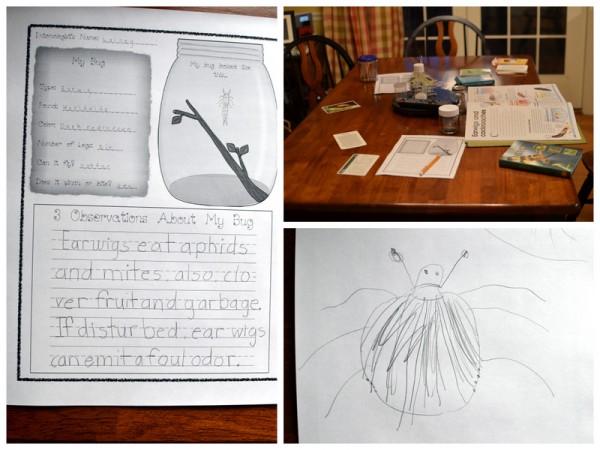
I’m not ready to wrap up this area yet–I’d like to talk about grasshoppers and flies. Barb mentioned spending six to eight weeks on one focus area and I think that will be a good time frame for us. At four weeks we still have more I’d like to cover, but after a couple more weeks we’ll be ready to move on.
Have you tried having a focus area for your nature study?
Our Homeschool Journal: A Full Week!
In our homeschool this week…
It was a busy, productive week. Our Time Traveler’s history focus was inventions of the 1800’s, and we had a lot of fun learning about the cotton gin, revolver, sewing machine, and steamboat and how these inventions impacted life in early America. Daddy, a licensed amateur radio operator, stepped in as a guest instructor for Morse Code. I need to arrange guest instructors more often! It was a highlight of the week.
We studied the phylum Cnidaria in our science curriculum (RSO Life Level 1), with a hands-on model of the jellyfish lifecycle.
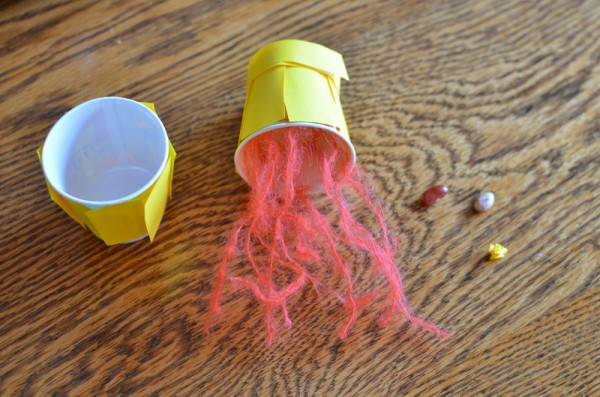
In other science learning, nature study was part of nearly every day! I’m so thankful Barb makes it easy to implement nature study because it adds so much enrichment to our homeschool. The kids checked a few more things off the Last Days of Summer grid while I worked in the garden. We took a little walk another day and did Challenge #1 from the Outdoor Hour Challenge ebook.
Our item of interest ended up being mushrooms and we learned about them after returning home. The topic that intrigued us was related to our earlier science studies about plant cells and chloroplasts–why are mushrooms not green? Using the Handbook of Nature Study we learned it’s because they don’t have chloroplasts to manufacture their own food, but use decaying plant matter for food, thus doing the world a great service in addition to feeding themselves!
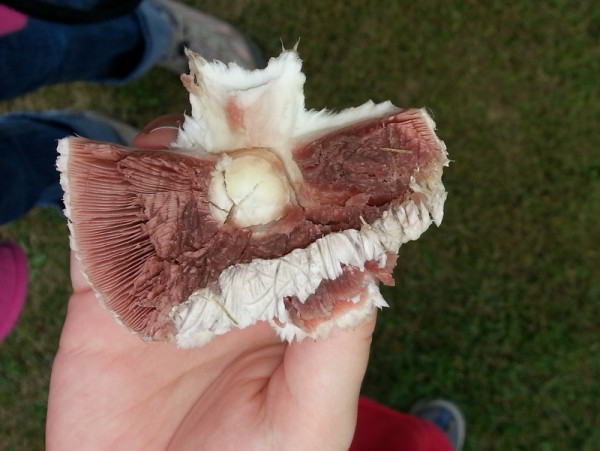
We also did the weekly challenge on ants. Our backyard ant hills are a bit quiet this time of year, but we tried to stir them up a little and noticed we have a least two different kinds making a home near our gardens. It was fun, as usual, to see the differences in what my kids were interested in: my daughter loved the structure of ant hills with separate rooms. We read the information in our books and then also did a little internet research to find some diagrams. My son was intrigued by the information in the Handbook of Nature Study on ant battles and how they can go on for days and involve fighting to the death.
The other idea from Barb’s Getting Started ebook was to pick a Focus Area, and for us the next month or two will be all about Insects and Spiders! I really like the idea of a nature focus area, and we have a catch-all console table that I’ve now turned into our nature study table. I combed our shelves and came up with several books and flash card sets. My son has a few interesting specimens in acrylic and we have a few insects we’ve collected in jars. I’ve set these all up on our nature table and we’ll be on the lookout for opportunities to study insects and spiders in our nature study.
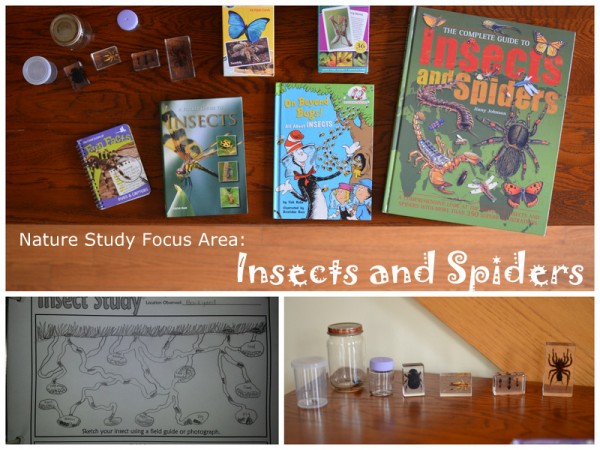
Helpful homeschooling tips or advice to share…
No need to be derailed by minor illness! My youngest was starting with a cold one morning. I’m always thankful I don’t have to ask myself: “Do I send him to school or not?” That used to be so tricky, trying to weigh how they felt or if they were infectious with what they were missing. We don’t call off school at home for minor illness, but try to make adjustments to continue learning and give comfort to whoever is under the weather.
First step: The Sick Couch. That’s an official family name for the cozy spot we bestow upon the sick member, loaded up with pillows and blankets and stuffed animals. We pull the table closer and stock that with tissues and treats. This time I made a homemade hot chocolate that was well-received.
Then we continue with the things we can (all from the “sick couch”) and usually make adjustments like extra reading aloud or an educational show. This time we brought out our popular Magic School Bus Human Body DVD and he watched “Inside Ralphie” while I worked with his big sister.
Places we went and people we saw…
Did you know that a little town in Maine was involved in the War of 1812? We had a fabulous time at Hampden Heritage Days, a free event put on by the historical society at a historic home.
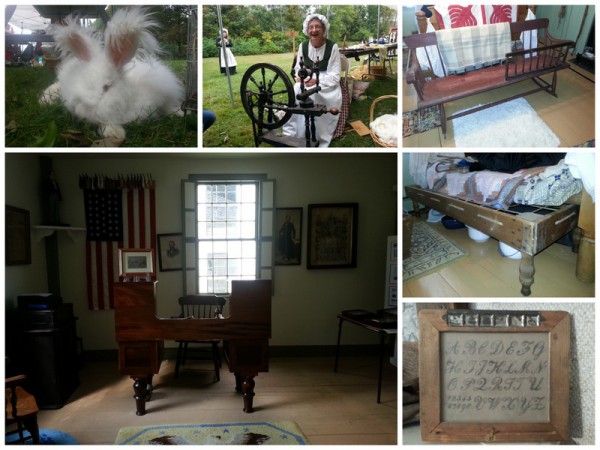
We learned about the Battle of Hampden and a chambermaid who threw the contents of a chamber pot on some British soldiers attempting to gain access to the home. We were able to step inside Hannibal Hamlin’s law office (vice-president with Lincoln during the Civil War). We also enjoyed many glimpses into life in another time period, and imagined what it would be like: sleeping on a rope bed, having to hand-make so much of what you needed, and handwriting that was really an art form. Some of it looked hard, but some of the simpleness of the time is always appealing. I loved the “Nanny-Rocker” where a mother could lay her baby to rock while having her hands free for handiwork, or how the spinning wheel was made to be portable so women could bring them when they socialized.
My favorite thing this week was…
Good friends coming to dinner! I love the flexibility we have to schedule social time as a family, and I also love when we have guests because my husband cooks the not-so-healthy meals that we generally avoid like creamy haddock chowder!
My favorite resource this week…
Erica from Confessions of a Homeschooler posted her World’s Greatest Artists study for FREE this week. The printables and activities are a great addition to our Harmony Fine Arts curriculum and I was excited to download it and go further in our study of Renoir this month! I’m continually amazed and appreciative of homeschool bloggers sharing their hard work and talent with the rest of us!
Things I’m working on…
Putting together our first unit study for the year: it’s a little mix of Elections, Government and the Presidency geared for elementary age students. I’ll post my plans as soon as I finalize them–hopefully within the next few days after I receive all the books I’ve ordered.
We’re reading…
My 10-year old is still working on Nancy Drew and the Clue in the Crumbling Wall, while my 6-year old pours over a book on Tanks. Our read alouds are On The Banks of Plum Creek from the Little House series, and Treasure Island. Yes, the full, unabridged version! I was wondering how my six year old would do, but it is pirates after all! I found an audio version but it was read too quickly, so I’m reading it with as much panache as I can manage, and going slowly enough and stopping often enough to be sure they understand. As we’ve gotten into the story we’re all really enjoying it. I love the opportunity to read all the great books I missed!
I’m reading For the Children’s Sake by Susan Schaeffer Macaulay. I have it on interlibrary loan but will be adding it to my shelf when I can: it’s one of those I could see myself re-reading frequently for inspiration and encouragement in the Charlotte Mason philosophy.
Thank you to the wonderful hostesses with fun link-ups on Fridays. Be sure to join the fun and see what other homeschoolers are up to!
Our Homeschool Journal: Nature Study (No Thanks to Mom)
In our homeschool this week…
We spent most of the week camping. It was our last trip since here in Maine the nights will be getting too chilly for sleeping in a pop-up camper right next to the ocean. I said we were going to try and cross off everything on Barb’s Last Days of Summer grid, and we got a running start: seven boxes checked off!
Other than the grid I had planned on the week being pretty low-key for education. I brought along an art project (more on that later) and our current book for reading aloud, but otherwise planned to just relax before we start full-time school next week. A lucky circumstance turned this trip into an educational treasure! While beach combing we noticed a lady searching alone. My six-year-old, who we think may be a politician someday, struck up a conversation with her. Turns out she used to work in education and was here for the summer as a volunteer to work on interpretive materials. How lucky for us! She seemed to enjoy the company of our kids and we left knowing a lot more about nature at our favorite place…no thanks to me and my fabulous homeschool mom planning.
The favorite tidbit my kids picked up was when my daughter asked this kind lady what made the little tiny holes in mussel shells. Turns out it’s a snail called the dog whelk. It eats mussels, which are larger than they are, by attaching to their shell, using a chemical to soften the shell, and then using their radula (like a tongue) as a drill to make that little hole. A squirt of their special saliva drugs the mussel, then a digestive enzyme turns the mussel to soup, then they suck it out through their tiny hole. Fascinating!
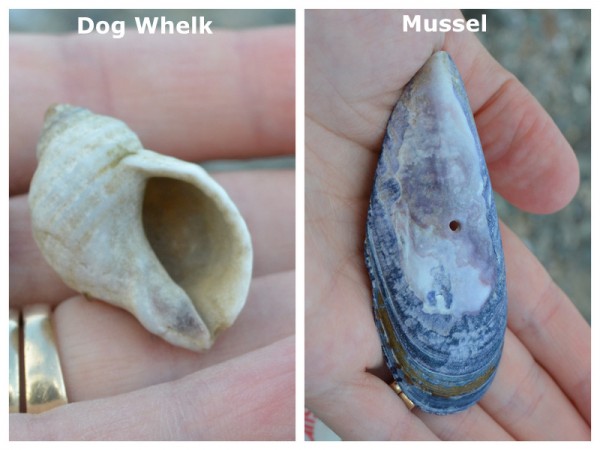
Since schools in our area are back in session it was pretty quiet at the beach. We were able to witness more activity from the seagulls than usual. We became intrigued watching them feed. They would pick things up from the ocean and fly up over the beach to drop them on the rocks and eat what was inside the shell. I was able to run to catch a closer look when one gull was done, and found his just-emptied sea urchin shell. We also witnessed the demise of a starfish. We decided a gull’s life looked pretty hard, but that they appeared pretty clever, too.
Helpful homeschooling tips or advice to share…
Be friendly! You never know what you can learn from people you meet just by striking up a conversation. My husband has encouraged me to be more like this over the years, and I see his personality trait in our son. Honestly, when I’d seen the woman on the beach I was sitting in the shade in my folding camp chair reading. I didn’t really want to chat, and I wasn’t even engaged with my kids combing the beach. Good thing my son followed in his dad’s footsteps!
My favorite thing this week was…
The weather! We’d had a lot of rain on our camping trips this summer, but the weather this trip couldn’t have been better. Warm and sunny but not humid or too hot, and perfect nights for campfires.
My favorite resource this week…
The art project I brought along on our camping trip was a chalk pastel tutorial from Hodgepodge. Their Nana gives them pastel lessons (lucky!) and Tricia kindly posts them for us to enjoy. We had a great time attempting to capture the beautiful sunsets over the ocean. If you haven’t tried one of Nana’s pastel tutorials I highly recommend it! It’s messy and fun and easy for all ages to create something special.
Things I’m working on…
Laundry. Post-camping laundry sometimes makes me want to run and hide. I also need to pull things together for the first week of school so I am organized with things printed or copied and ready to go.
I’m reading…
We’re near the end of Little House on the Prairie and enjoying this series so much!
I finished Beyond Survival: A Guide to Abundant-Life Homeschooling by Diana Waring. I can’t say it’s one I’d read again. I did enjoy the chapters on different learning and teaching styles and teaching multiple ages. I gleaned a bit from it, but though I don’t think the author meant it that way some sections made me feel we weren’t good enough. For example, when we visit with other families we don’t gather around the table and sing together. We try to get the kids to go play so us adults can talk. I’m looking for another, possibly more encouraging (and realistic for me) homeschooling book to read. Any suggestions?
I’m grateful for…
The seasons. I love the changes and trying to enjoy the best that each season in Maine has to offer.
Thank you to the wonderful hostesses with fun link-ups on Fridays. Be sure to join the fun and see what other homeschoolers are up to!
Nature Study ~ Enjoying the Last Days of Summer in the Garden
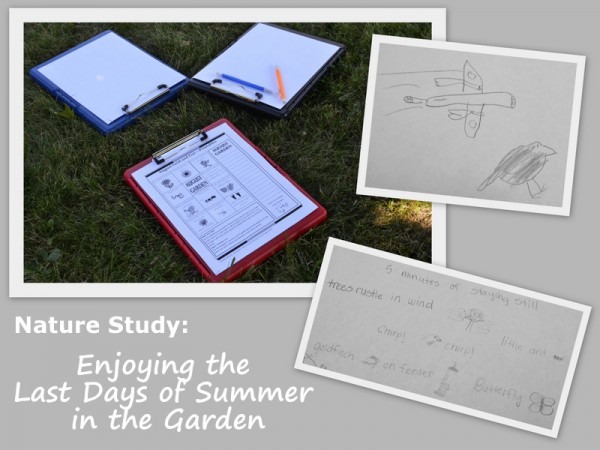
The last Outdoor Hour Challenge from Barb at the Handbook of Nature Study blog for August was all about enjoying these last warm days in the garden. Barb loaded us up with ideas for spending a little extra time outdoors. It was wonderful because not only were the ideas easy to do, but they had us all noticing little details and soaking up the garden with all our senses.
My favorite activity was probably sitting quietly in the garden for five minutes. That’s an unusual activity for a family with young kids! I set us up on a blanket in the shade with our nature study clipboards and we recorded what we heard and saw. 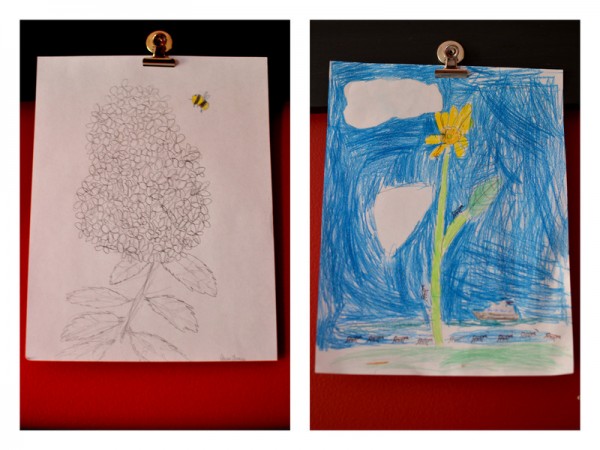
We also brought a couple flowers inside and the kids drew them for their nature journal…and like Barb suggested they drew them BIG. I love having the kids draw things they see–it really slows them down and they notice details.
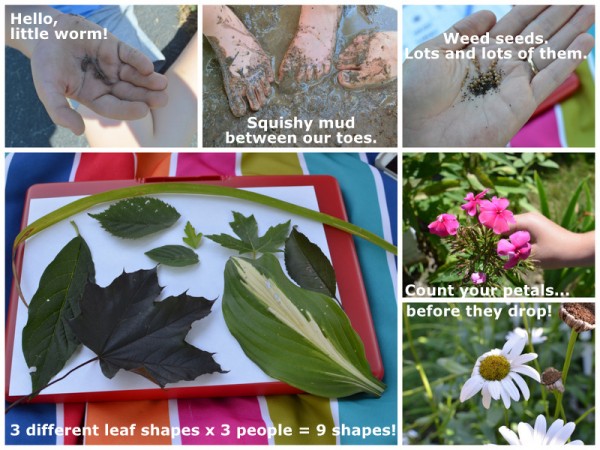
We did all the activities on the August Grid over the course of the week. The weather was beautiful, and we soaked it up. It’s good for those of us in Maine to try and store up as many summer memories as we can: our seasons are already preparing to change. You can feel the difference in the air at night, and many of my garden flowers are rapidly declining. It’s all good because fall is my absolute favorite season: crisp air, picking apples and pumpkins, jumping in piles of leaves! I’m not going to think right now about January, February, March…winter is long here but I’m enjoying the rest of summer right now. Barb posted another grid from her archives–it’s loaded with ideas and we want to accomplish them all!
I’ll be submitting this to Barb’s Outdoor Hour Challenge Blog Carnival.

Nature Study ~ Saying Goodbye to Our Monarch Butterflies
Watching the metamorphosis of a caterpillar into a Monarch butterfly first hand was the highlight of this summer’s nature study. I wrote about finding Monarch caterpillars and observing them form a chrysalis a couple weeks ago. We watched the jewel-like chrysalis and patiently waited. Finally one morning the first chrysalis looked dark, and if you looked closely you could see the beautiful orange and black wing pattern!
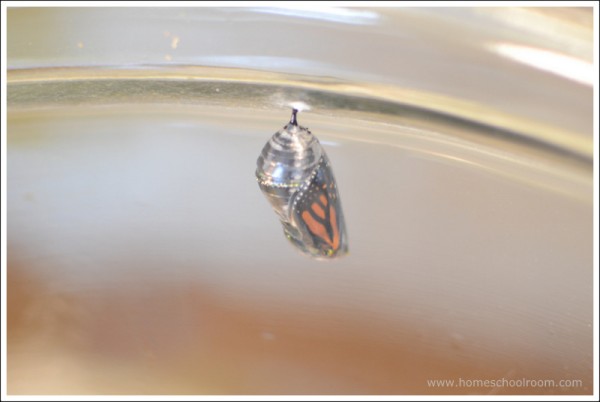
We were so excited and began watching, hoping to see it emerge. I had read they usually emerge mid-morning so we tried taking turns watching and I set my camera up for time lapse photography. We watched all morning and my camera took photos until the battery died…no butterfly. No one was watching when he finally emerged after lunch. This was the same caterpillar (“Big Guy”) who formed a chrysalis when no one was watching, too, so perhaps he’s shy!
Two days later it was Little Guy’s turn. The morning that we could see his black and orange pattern we were set to leave for a day trip, so I prepared the kids that we would miss his emergence, too. We were bustling around getting ready and I happened to peak in and could see a crack forming in the chrysalis! I yelled to everyone (causing the dog to bark wildly) and all four of us watched in awe as he emerged.
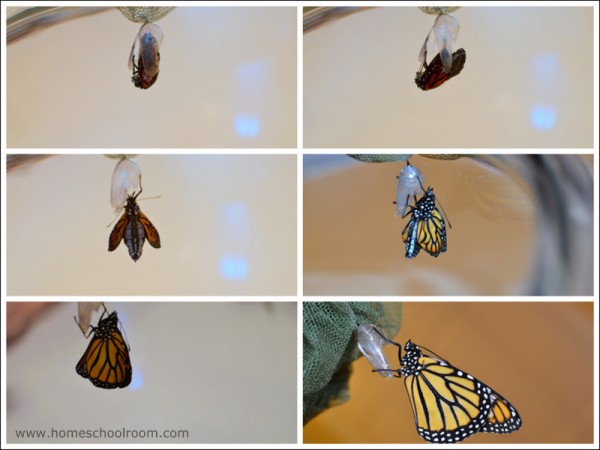
“I love you!” whispered my ten-year-old daughter, as if to a newborn baby.
“This is the most exciting thing of my life!” exclaimed my six-year-old.
Watching the emergence was amazing, especially how the body of the caterpillar was plump and the wings appeared small and shriveled. I had read that they need to pump blood into their wings, but hadn’t thought of where the blood would come from! We watched the body grow smaller as the beautiful wings expanded.
We had enough time to take in every detail of these beautiful creatures. We were reminded of things we’d learned during our nature study: we caught a few glimpses of the amazingly long proboscis, we noted the brightly colored surface of the wings when open, but the paler color of the underside when closed, we counted the four longer legs but looked closely for the two smaller legs near the mouth. The awe and wonder of a plump striped caterpillar forming a jewel-like chrysalis that appears to be adorned with gold, only to emerge 10 days later as this lovely fluttering butterfly!
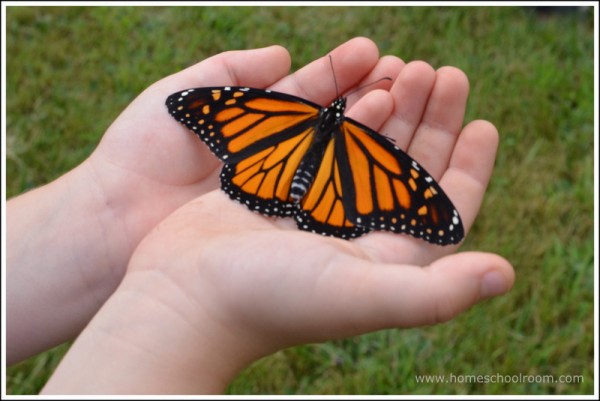
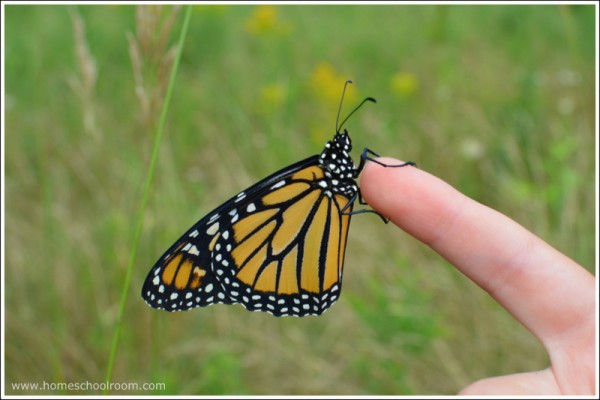
We released both of the butterflies on the same day that they emerged, back into the lovely wildflower field we had found them in as tiny caterpillars. Off they fluttered as we said goodbye. We all hoped they were the generation of Monarch butterflies that gets to go to Mexico for the winter!
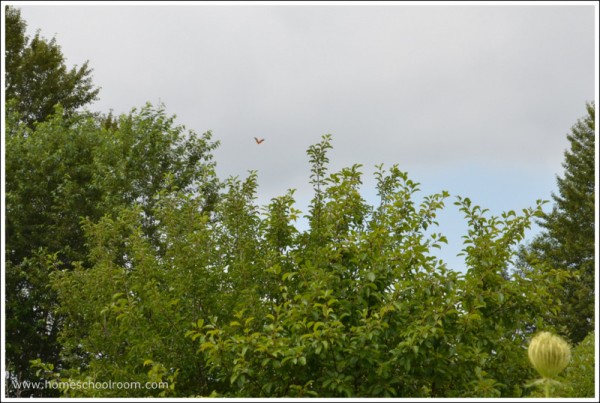
My kids turned to me and said, “We’re going to do this again next year, right?”
Absolutely!
Last Child in the Woods ~ Changes for the Future
I’m here with more thoughts on the book Last Child in the Woods by Richard Louv, joining in Nicole’s book study. Be sure to visit her at Journey to Excellence for her thoughts on these chapters and the big changes her family is making.
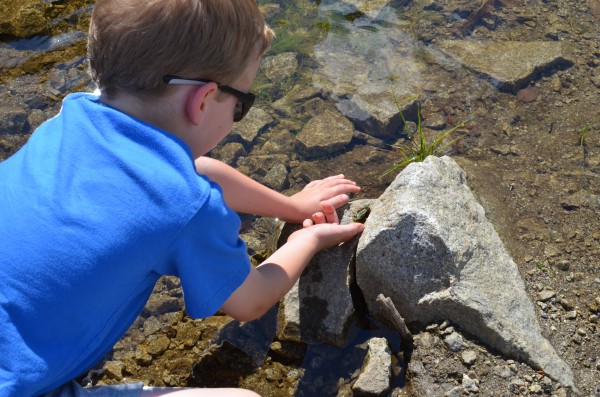
Chapters 18 through 20 in the book discuss ushering in the “fourth frontier” and reconnecting not just ourselves but our culture with nature. These chapters have very big, far-reaching goals that really involve a restructuring of how people live. The author’s point is that we can connect our kids with nature right now, but we need to make changes to our culture or the child-nature gap will continue to widen. I agree, but changes in population distribution sounds too orchestrated to me. I enjoy living in a rural area. If we were moving I would be interested in towns with a big connection to nature. But can you force those interests on the population as a whole?
I’ll admit this: he loses me a bit in these conversations. I tend to think small and change what I am in control of, versus getting involved in larger organizations. I pulled my kids out of school instead of working to change the school system. I was very excited to read the ideas for reconnecting myself and my children with nature that are within my immediate control–things I can implement on my own right now. But when the author talks of sweeping changes in the structure of towns and cities and businesses I feel more overwhelmed than able to help. Clearly there are movers and shakers who get involved in politics and organizations that make sweeping changes, and I’m grateful for them and benefit from the work that they do…but I’m not one of them.
In the discussions of cities he talks of making nature corridors, not just isolated parks that don’t look natural at all. The discussion of allowing movement and genetic diversity did hit home for us: we’ve been studying monarch butterflies and their amazing migration. They need milkweed plants as they migrate north from Mexico in the fall. If they don’t have milkweed plants to lay their eggs on in the southeast, we won’t have monarch butterflies in the summer in the northeast. My plan of action is growing my own milkweed patch, doing my small part. But I do hope the movers and shakers, like the Monarch Watch organization, are successful in protecting these amazing creatures.
Another small part I have been learning about for a while now as a gardener is using native plants that are less resource intensive. I live in a manicured neighborhood and am one of the very few that doesn’t spray my lawn with chemicals. It shows–my lawn is probably 50% clover and dandelions and other “weeds” BUT I haven’t suffered from the grub damage (grubs eat grass roots, not weed roots) of my neighbors with perfect lawns. I also have one of the greenest lawns right now because my weeds are surviving the drought much better than the grass of my neighbors. The reason I don’t spray: my kids and dog can play on it anytime without fear of chemical exposure.
In short, these chapters had interesting ideas, but didn’t give me ideas for implementation in my daily life. There are just three chapters left in the book. Join us for the last installment in this book study later this week or early next week.
Nature Study ~ Mesmerized by Monarch Metamorphosis
I really wanted to raise caterpillars into butterflies for the kids to watch. I really wanted them to be monarch caterpillars. We’d done it years ago and the amazing process is still etched in my mind but even my 10 year old’s memory of it is fuzzy. The caterpillar is striking and not hairy (my son got hives from a hairy caterpillar last year so both my kids now refuse to touch any caterpillars with hair), the chrysalis is like a jewel, and the butterfly is beautiful. The problem: I couldn’t justify the $26 in shipping charges to order monarch caterpillars.
I was determined and, after looking at countless images online felt I could recognize milkweed–the only food monarch caterpillars will eat. This was one of those times when my husband just shook his head, because he knows I get an idea in my head and can’t let it go. He chuckled as I looked into roadside wildflowers on our walks and in the car. I took my family on some crazy back-road drives until I found a country road with tons of milkweed…and I went searching. Here’s me up to my waist in a field of milkweed, searching for teeny-tiny caterpillars. I would have been happy with eggs, too, but since they’re the size of the head of a pin I decided that just might be impossible. My family cheered me on from inside the bug-free car as I battled the mosquitos.
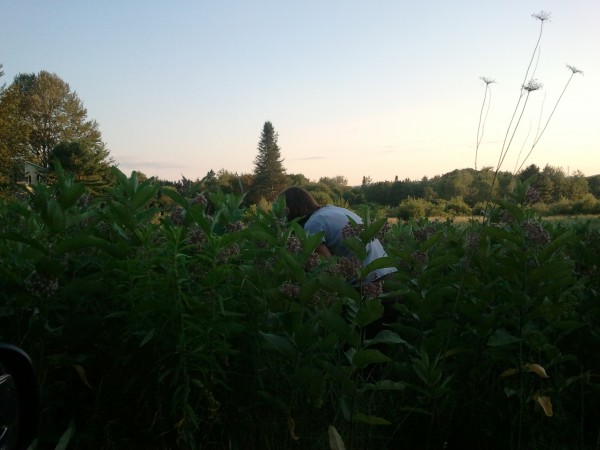
Finally–success! Two monarch caterpillars came home with us. The smallest one (dubbed “Little Guy”) was so tiny he was still whitish with a dark head. “Big Guy” was already getting the striped pattern characteristic of monarch caterpillars. We set them up right in the middle of our kitchen island. Yup, we’re homeschoolers.
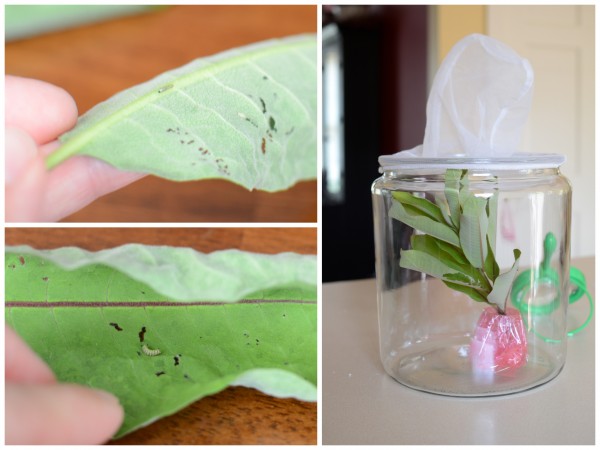
It was amazing how fast they grew! We had several opportunities to watch them molt. We were in awe of how much they could consume in a day, and how much frass (new vocabulary word for my son to avoid the common word for it) they could make.
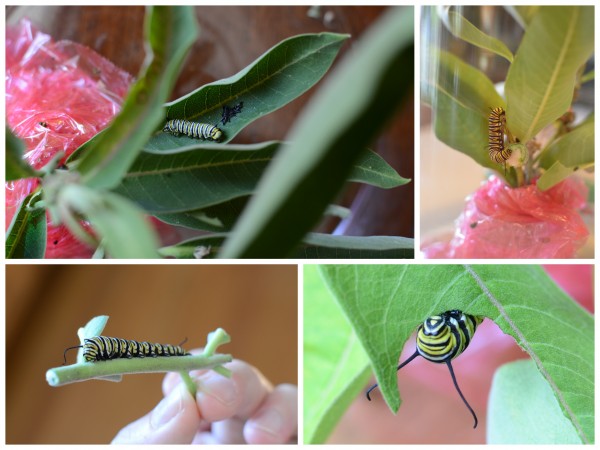
I found that keeping the stems in a small jar of water kept the leaves fresh enough to last a few days, since I had to drive to get leaves for them. One morning I woke up to this and had to go get more leaves before everyone was even out of bed!
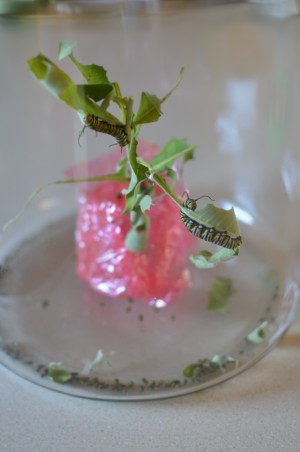
Finally the moment we’d been waiting for: Big Guy moved to the top of the container, attached himself and hung upside down in a “J” shape. We watched with excitement but ended up missing the moment of transformation into a chrysalis!
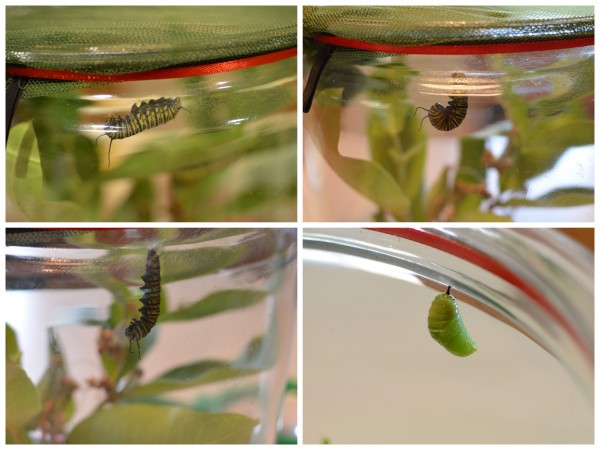
When it was Little Guy’s turn a couple days later my kids were determined not to miss it. I was afraid it would happen in the night and they didn’t want to go to bed. Mr. Tech Support (my husband) saved the day. He reminded me that the fancy camera he bought me can do time lapse photography, so we set it up to take photos all night long just in case. (Okay, maybe we’re crazy…but the kids were excited and I wanted them to sleep!)
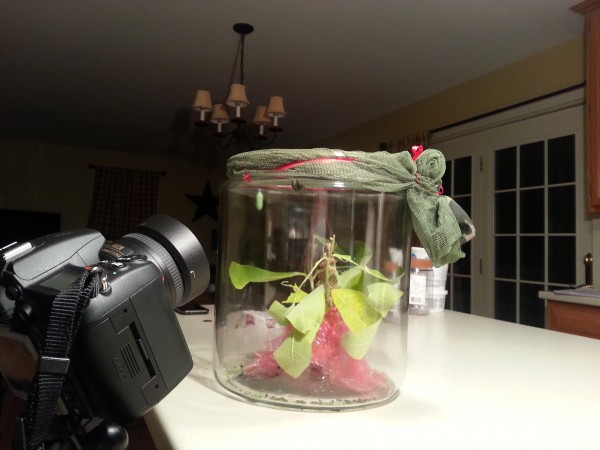
The caterpillar was still hanging in a J-shape the next morning so we set ourselves up to provide constant surveillance. I decided to keep the camera set up taking time lapse because it was really neat now that I’d figured out how to do it. (In fact, I may be taking time lapse photos of everything from science experiments to the cat napping. It’s fun!)
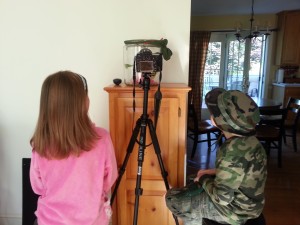
We made sure one of us had our eyes on it the whole time. Finally my daughter yelled and we witnessed the amazing transformation of this black, yellow, and white caterpillar with legs and antennae to a pale green chrysalis with a completely different shape. If you are interested here is my first amateur attempt at time-lapse photography:
We were amazed at the transformation, and how much the early pupae moved about to shed the old skin and attain its final form. Initially you could see the ridges from the caterpillar’s body and some striping, but the color changed and the chrysalis became more opaque. By the end it was a smooth, lovely shade of green. My favorite part are the markings that look like drops of gold paint. Truly amazing.
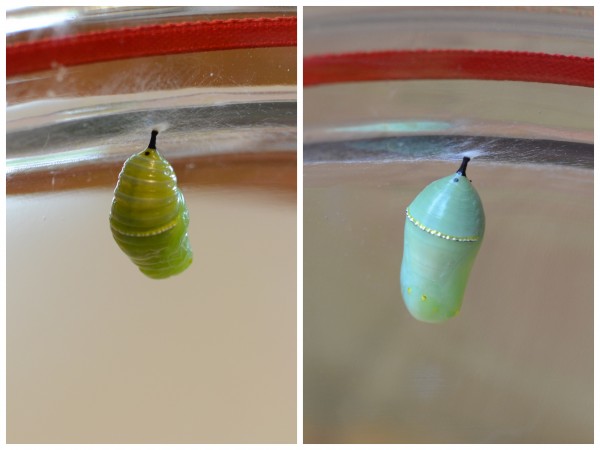
As we’ve been mesmerized by this process we’ve learned a lot about monarchs and butterflies in general using these resources:
- Real Science Odyssey Life Level One: Our new science curriculum had a unit on insects with specific labs about caterpillars and butterflies, so we did the corresponding lessons and journal pages. It meant working out of order but we had to work with nature on this one!
- Go-Along books:- It’s a Butterfly’s Lifeby Irene Kelly: This book has great information on all kinds of butterflies with beautiful drawings, and also fun facts about defense mechanisms and frass (both of particular interest to a six-year-old boy).- The Magic School Bus and the Butterfly Bunch: A good book for covering the life cycle of butterflies.- National Geographic Kids Great Migrations: Butterflies by Laura Marsh: This book has terrific photographs to illustrate the migration of monarch butterflies, a truly amazing feat.
- Magic School Bus episode “The Butterfly and the Bog Beast” (on our Bugs, Bugs, Bugs! DVD): The Magic School Bus show is a favorite around here. This episode gives great information on how butterflies are tough little creatures with many defenses.
- We used just about everything Barb put out for the Outdoor Hour Challenge on monarch butterflies. I highly recommend the You Tube vidoes on monarch migration–it really is an amazing journey! We enjoyed all of the links under “suggested resources to view or print” from learner.org. They have easy-to-understand information on monarchs and their annual cycle, and the link about wings was information we hadn’t read elsewhere. The corresponding information from the Handbook of Nature Study led to some microscope fun: we pulled out our pocket microscopes after I found these unfortunate guys in our garage.
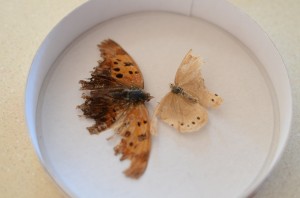 We’d read how the wings are covered with scales arranged in perfect rows, so it was wonderful to see for ourselves. It was also neat to read about the actions of the antennae when the caterpillar is frightened, something we’d observed when we spoke too loudly near the top of their glass container.
We’d read how the wings are covered with scales arranged in perfect rows, so it was wonderful to see for ourselves. It was also neat to read about the actions of the antennae when the caterpillar is frightened, something we’d observed when we spoke too loudly near the top of their glass container.
So now we anxiously await our butterflies. We think of Big Guy and Little Guy just under that green covering, preparing to become creatures that can fly. The transformation takes 10-14 days. This has been an amazing study, and for our family reinforced the wonders of God’s creation. I’ll be sure to update with photos when our butterflies emerge!
***Updated: Here is the post on our Monarch butterflies emerging and being released into nature!***
I’m submitting this to Barb’s Outdoor Hour Challenge Blog Carnival. Be sure to visit her site for nature study ideas, and watch for her blog carnival to see all the amazing summer nature study happening.
Last Child in the Woods ~ Nature in our Homeschool
I’m here with my thoughts on Chapters 15-17 of the book Last Child in the Woods by Richard Louv. I’m participating in a book study hosted by Nicole of Journey to Excellence, be sure to visit her to read her thoughts on these chapters.
Chapter 15 discusses activities that offer a reason and focus for being in nature. Birding and nature journaling were two that we have enjoyed so far. Bird watching is one that my children and I had the pleasure of trying this past winter when we participated in the Great Backyard Bird Count. We prepared by learning about the birds in our area, then over the weekend of the GBBC we enjoyed our roles as scientists tallying birds and submitting our numbers to Cornell University. It occurs in the dead of winter here in Maine and it was great to have a nature-related activity to focus on. Nature journaling is another new-to-us activity mentioned in the book, and we’re all enjoying that through the recommendations of (once again) Barb at the Handbook of Nature Study blog. We often use her notebooking pages for some direction on what to draw. I have found that drawing an item really helps my children pay attention to the details.
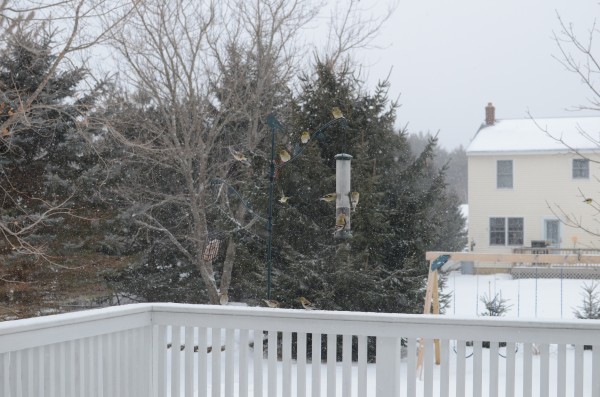
At the beginning of Chapter 16 when I read the statement that teachers should free kids from classrooms I said to myself–that’s my whole philosophy behind homeschooling! Not just so they can experience nature, but the world and its people and places. Then on page 211 there was a quote from a teacher: “This isn’t memorizing information for a test…this experience becomes part of you.” Hello! Again, this is the core of homeschooling for me. For me, school was about memorizing information for a test and then promptly forgetting it! I hope to show my kids a different experience.
This chapter discusses many hands-on nature programs and the success of the students in them. I was thrilled because many of the ideas mentioned are happening somewhere in our home right now–square foot gardening in the backyard, caterpillars growing fat on the kitchen counter, and tadpoles just beginning to get their legs on the deck. This is what science is all about for us at the elementary level: things that the kids can see and touch and be amazed at.
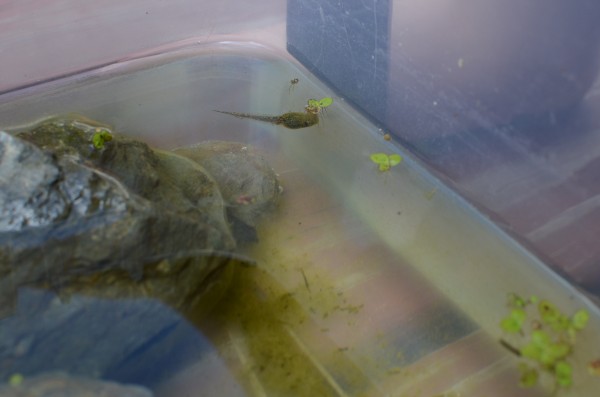
The last quote again hit me as a comment on homeschooling in general: “An environment-based education movement–at all levels of education–will help students realize that school isn’t supposed to be a polite form of incarceration, but a portal to the wider world.”
Chapter 17 talks about summer camps being a way to make nature more accessible to kids, and a lot of that discussion wasn’t really relevant for me. For our family, camping together at state parks provides the beneficial experiences and works for us while my kids are fairly young. We aren’t staying in a fancy camper with a bathroom, air-conditioning and television. It’s a pop-up with no plumbing, wooded campsites, and sleeping with the windows open.
I was interested in the author’s discussion of schools spending so much money on soon-to-be-obsolete electronics when they should spend it on natural areas where teachers can take their students to learn with all five senses. Case in point: our town just built a gigantic new high school surrounded by huge parking lots and athletic turf and running tracks. There is no natural area to spend time in, the library is smaller than before, and yet students will receive iPads to use. I also found out the other day that our middle school children have no recess at all. None. Parents were surprised that I thought this was sad! It didn’t seem to bother them that 12 year old kids don’t have time for recess or even 15 minutes of fresh air.
These chapters mark the end of the section of the book with ways to connect your children with nature at home and through their education. The next section is dedicated to ushering in what the author calls the “Fourth Frontier:” reconnecting our society as a whole with nature.



